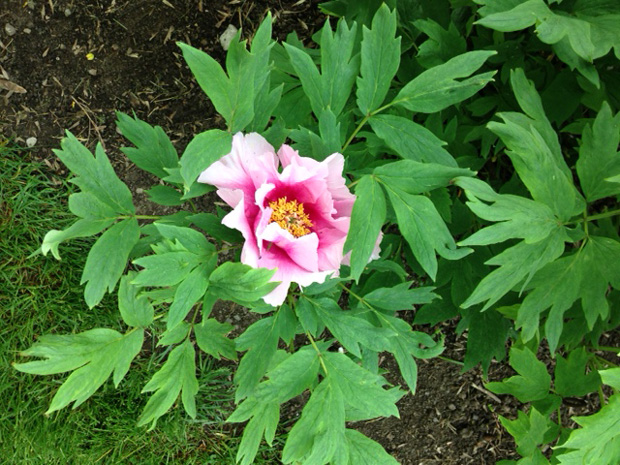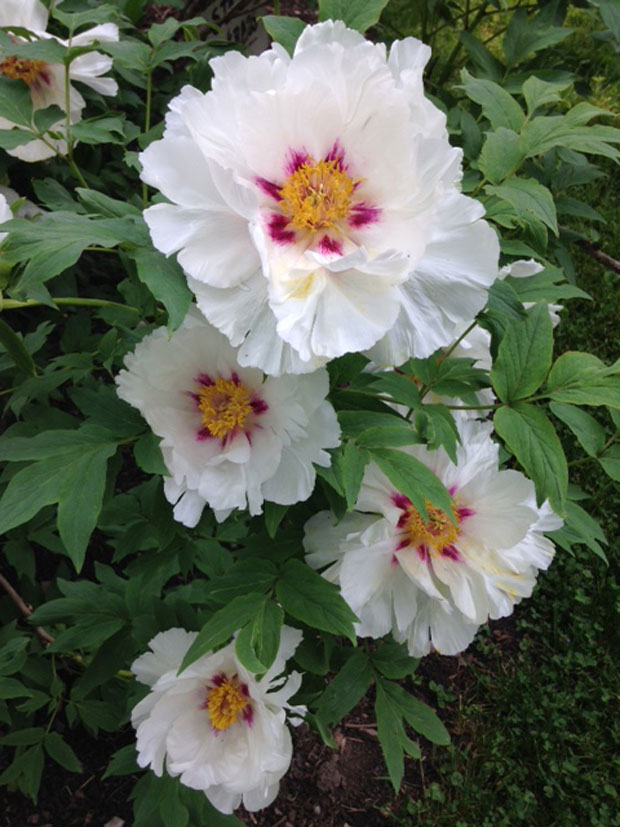Consider the Tree Peony
The river is smooth and calm this evening,
The peony flowers bloom.
The moon floats on the current.
The tide carries the stars.
—Qian Qi (Tang Dyanasty)
About one hour east of Buffalo, where the Hamilton shale strata yielded New York State’s first forests between 382 and 360 million years ago, a small town called Pavilion hosts an unusual gardening event in late May. The Linwood Tree Peony Festival is serene, understated, heady, impressive, and an event no Western New York gardener, preservation enthusiast, architect, or nature photographer would want to miss.

This year marked the 20th anniversary of the event, held on the grounds of Buffalo lumber baron William H. Gratwick, Jr.’s circa 1900 summer home. You can see touches of Gratwick’s casual flair for the immediate here and there, and one must travel to Pavilion to do so, since all corporal evidence of his life and history here in Buffalo were long ago demolished. There is something about feeling a breeze, observing a view, inhaling a fragrance that no photo or written testament can capture. Journeying, literally traveling, to experience transformation is something that Gratwick seemed to understand, both personally and creatively.
I could do that—I wonder how many people have walked away from these gardens thinking just that. This is my second sojourn to the festival in five years and I was stricken, mostly, by how very little if anything changed. It is haunting. Immaculate, casually maintained garden rooms everywhere. Forget-me-not bordering nearly every bed not devoted exclusively to tree peony cultivation, and some that do. The heat of the sun, the muted rolling hills, the songbirds all beckon you in. I suspect these modestly maintained walled gardens would turn any would be gardener into an enthusiast, or at least markedly less reserved about making the attempt, before visit’s end.
“Want something that blooms all summer? Plant petunias or pansies.” —William Gratwick, Jr.
Imagining the one fleeting life that Gratwick and his family enjoyed here, juxtaposed against the long lived tree peony with its short-lived flower, is literally breathtaking. Gratwick was questioned once why he cultivated and bred tree peonies, and his answer is above. The place, his experience of it, of his family, is so very much like the flowers he was so devoted to. I do wonder if he realized that. He must have. Or maybe I’d just like to think so. Their ancient association with royalty in Chinese culture likely held some appeal as well.

Chugai Seedling (Lee Gratwick, 1960)
So what are tree peonies? They are not actually a tree, but a shrub with tree-like, barked stems. They must be differentiated from their close kin, the peony. The traditional peony “dies back” every year, which means the entire plant, stems and flowers, emerge anew from the ground every year. The tree peony does not die back but may keep, spread, and build upon its woody frame every year. They are documented for millennia in Chinese culture and found their way to the US in the 1820s. The peony has been used in medicine for millennia as well. Also distinguishing them is the sheer size of their blooms, generally between six inches and a foot in diameter. Sometimes fragrant, other times not, they are impressive, showy, and lovely. It is not difficult to understand why these plants are a revered collectible.
Gratwick was a cultivator and breeder of Japanese and American tree peonies. He provided Nassos Daphnis, an artistic Spartan and arguably one of the greatest hybridizers of tree peonies, an arena in which to cultivate his gift. One of the many blooms there struck a chord. The Chugai Seedling was first introduced in 1960 by Lee Gratwick, granddaughter of William Gratwick, Jr. The parentage of this plant is unknown, which means that it was not intentionally hybridized. Somewhere between William Gratwick, Jr. and Lee Gratwick, out there in the fields, it was born of breeds such as Guardian of the Monastery and Companion of Serenity. A wild child, unplanned, self-cultivated, each individual plant shares similar traits but is unique, vigorous, fragrant, growing to four or five feet.
“One sky, toward which we sometimes lift our eyes tired from work: some days guessing at the weather of our lives, some days giving thanks for a love that loves you back, sometimes praising a mother who knew how to give, or forgiving a father who couldn’t give what you wanted. We head home: through the gloss of rain or weight of snow, or the plum blush of dusk, but always, always home, always under one sky, our sky.” —Richard Blanco
It’s delightful, the way this beauty turns its blooms to the sun. All, together, smiling upward, drinking in the day. Reminding us of how time passing. Seeing all of this in a tree peony—observing its view, inhaling its fragrance, is a rare and appreciated gift.

